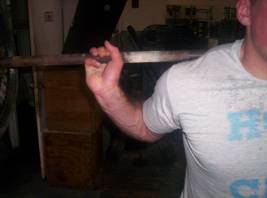Shoulder Mobility for Squatting
Q: Recently, I’ve noticed that I’ve lost a lot of mobility/flexibility that means I can’t squat with my hands close in and with a high bar like I used to, I now have to go low bar and hands almost at the collars. What stretches/mobility work would you recommend to remedy this problem? I don’t think this situation’s very good for my shoulder health.
A: It’s a common problem, and while the solution is pretty simple, it takes a dedicated effort to regular flexibility and soft tissue work. And, you’re right that it isn’t very good for shoulder health; that low-bar position can really wreak havoc on the long head of the biceps.

For starters, it’s important to address thoracic spine mobility. If you’re rounded over at the upper back, it’ll be impossible to get the bar in the right “rack” position – regardless of what’s going on with the shoulder itself. The first thing I do with folks in these situations is check to make sure that they aren’t doing any sit-ups or crunches, which shorten the rectus abdominus and depress the rib cage, causing a more “hunchback” posture.
After you’ve eliminated these exercises from their programming, you can get to work on their thoracic spine mobility with drills from Optimal Shoulder Performance; one example would be thoracic extensions on the foam roller.
As you work to regain that mobility, it’s valuable to build stability within that newly acquired range-of-motion (ROM) with loads of horizontal pulling (rows) and deadlift variations.
With respect to the shoulder itself, it’s important to regain lost external rotation ROM and scapular posterior tilt. As I recently wrote in “The Right Way to Stretch the Pecs,” I prefer the 1-arm doorway pec stretch and supine pec minor stretches. You can find videos of both HERE – and you can expedite the process with regular foam rolling on the pecs.
In the interim, substitute front squats, overhead squats, single-leg exercises, and deadlift variations to maintain a training effect.
As you progress back to squatting, you can ease the stress on your shoulders by going with a pinky-less grip in the short-term.

That said, for many individuals, the back squat set-up may not be appropriate. These include overhead throwing athletes, those with flexion-based back pain (e.g., disc herniations), and individuals with posterior labral tears.
I’d estimate that only about 25% of Cressey Performance clients do a true back squat, but that’s influenced considerably by the fact that we deal with a ton of baseball players, and I get a lot of shoulder corrective exercise cases. Instead, we do a lot of work with the giant cambered bar and safety squat bar, in addition to front squatting.
Hopefully, these recommendations get you headed in the right direction and back to squatting as soon as possible!
What the experts are saying about The Truth About Unstable Surface Training…
“Unstable surface training is many times misunderstood and misinterpeted in both the physical therapy and athletic performance fields. The Truth About Unstable Surface Training e-book greatly clarifies where unstable surface training strategically fits into an overall program of injury prevention, warm-up/activation, and increasing whole body strength. If you are a physical therapist, athletic trainer, or strength training professional, The Truth About Unstable Surface Training gives you a massive amount of evidence-based ammunition for your treatment stockpile.”
Shon Grosse PT, ATC, CSCS
Comprehensive Physical Therapy
Colmar, PA
Click here for more information on The Truth About Unstable Surface Training.
New Blog Content
Random Friday Thoughts
Elbow Pain in Pitchers
Stuff You Should Read
The Most Important Thing for Rookie Trainers
Enter your email below to subscribe to our FREE newsletter:



